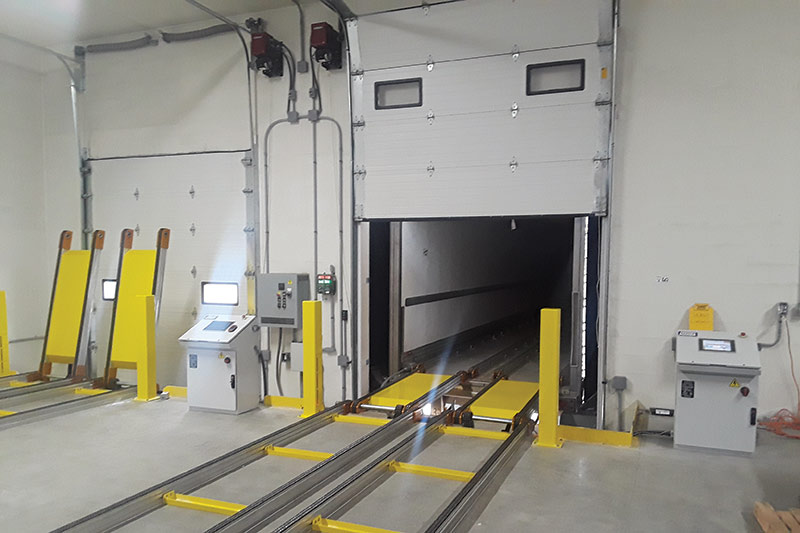Getting more ergonomic at the dock
Challenged by a labor shortage, high demand and regular employee turnover, warehouses and DCs deploy more ergonomic equipment and solutions on their loading docks.

Lifting heavy items, bending, reaching overhead and pushing and pulling heavy loads are fairly common practices on the loading dock, where roughly 25% of all warehouse injuries take place. Not all of those injuries are immediate or obvious. The employee who works in awkward positions or performs the same task repetitively may be prone to musculoskeletal disorders (MSDs) that impact the muscles, nerves, blood vessels, ligaments and tendons.
The good news is that work-related MSDs can be prevented. “Ergonomics—fitting a job to a person—helps lessen muscle fatigue, increases productivity and reduces the number and severity of work-related MSDs,” OSHA points out. “In the workplace, the number and severity of MSDs resulting from physical overexertion, and their associated costs, can be substantially reduced by applying ergonomic principles.”

While the potential for slips, falls and other accidents on the dock is always high, the hidden dangers of repetitive motions, heavy lifting and/or bending can easily be overlooked. With a labor shortage in full swing and many warehouses dealing with high employee turnover, outfitting the dock with ergonomic equipment continues to make good sense.
“Ergonomics in warehouses and DCs as a whole is always important,” says Rich Schlesinger, 4Front Engineered Solutions’ director for U.S. distribution sales of loading dock products. “Of course, any type of equipment can present dangers for workers, but ergonomics tends to be the one that sneaks up on you.”
In many cases, the attention paid to dock ergonomics depends on the operation itself. A manufacturing facility that has a safety manager, for example, may address the problem differently than a warehouse with a small staff and no dedicated safety manager. In other situations, the focus may be more on preventing slips and falls (e.g., by ensuring there’s no condensation on dock levelers as equipment moves from warm exterior spaces to cooler facility interiors).
“If someone is in charge of safety,” says Schlesinger, “they’ll usually be making sure tasks are being handled correctly and that ergonomic equipment is being used.” In any setting, he says the operation that’s using powered and push-button equipment stands the best chance of minimizing MSDs on the dock, where it’s not unusual to see workers bending down to pull a chain that activates a mechanical dock leveler.
“For some companies, mechanical levelers are just a way of life. Either they don’t have access to power or they don’t have a budget, so they just stick with mechanical levelers,” Schlesinger explains. “Right off the bat this puts them behind the eight ball with ergonomics.”
Knowing this, 4Front makes mechanical levelers that require just 10 to 15 pounds of force to activate. Less force required to pull the chain equates to less strain on the worker’s back.
“In most settings a push-button self-powered leveler is the best option,” says Schlesinger, “but if the company doesn’t want that, at least we can make it easier for an employee to pull the chain on a mechanical leveler.” 4Front also makes the Air Powered Dock Leveler AFX, which is a more affordable replacement for mechanical levelers. It runs on 120 V power, which is generally readily available on most loading docks. “If ergonomics is an issue,” Schlesinger, “the air leveler is a good solution.”
Minimizing repetitive injuries and strains
Loading and unloading vehicles, moving pallets of product around and bending down can all take their toll on the human body.
“Whether you’re overreaching, bending down or reaching overhead, when you do it over and over again you may wind up with musculoskeletal problems,” says Peter Norden, key accounts manager at Southworth Products Corp., which works to eliminate the bending, reaching and twisting that workers have to deal with on the dock.
Southworth’s hydraulic scissor lift tables, for example, can be used with a wide range of vehicles. When pit-mounted in front of the loading dock, the tables support pallet-jack loading from the ground level (the company also offers surface-mounted styles). And, its Backsaver series of hydraulic lift tables can be used for work positioning, assembly, order picking, pallet loading and other applications.
In the absence of a dock leveler, employees may be forced to manually load and unload any trucks or vans that can’t be accessed with a forklift. And speaking of forklifts, Norden says he’s been fielding requests from companies that want to be able to raise those vehicles up in the air.
“We’re making heavy-duty capacity lifts that can manage up to 20,000 pounds,” says Norden. “The entire forklift can be raised in the air and driven into the back of the truck to pick the pallets up. It can then be driven out onto the dock lift, lowered back down to ground or dock-height, and driven into the warehouse.”
When you let the dock lift and forklift handle the work instead of the employee, you eliminate the need for bending, reaching, lifting and twisting, says Norden, who is also seeing more demand for the PalletPal Spring Level Loader, which keeps loads at an ideal height for building or breaking down pallet loads.
“More companies want to be able to break down the pallets as they come off of the truck,” Norden says, “and if they can raise the pallet up in a way that allows employees to work without having to bend, reach or twist all around the pallet, it helps minimize repetitive injuries and strains.”

More push-button equipment
Companies want more push-button dock equipment that doesn’t require workers to come outside, bend over, walk on inclines and/or pull on chains to get trailers in place for loading and unloading.
“They want to get the operator away from the equipment, by adding push-button stations and letting the machine do the work of positioning the dock leveler onto the trailer bed,” says Walt Swietlik, director, customer relations and sales support at Rite-Hite.
Swietlik says Rite-Hite has always offered push-button dock levelers, but says there’s been an increased interest in these products over the last five years. In response, the company continues to develop new products, including the Rite-Hite Trailer Lift (RHTL), which helps raise vehicles to proper dock height.
It also levels the trailer bed to help protect cargo and make forklift loading/unloading more efficient and ergonomic. The RHTL’s design provides full access to different vehicle types and loads, helping to provide a universal fit regardless of vehicle bed height.
When selecting dock levelers for an operation, Swietlik says warehouse managers should factor in the length of the equipment. This is particularly important in situations where manual materials handling equipment (e.g., hand carts, manual pallet jacks, hand dollies, etc.) are in use.
“The longer the platform, the easier the ride will be in or out of the trailer,” says Swietlik. “This, in turn, can produce additional ergonomic benefits for workers by minimizing repetitive ‘bumps’ as they drive from building to floor to trailer floor and back.”
Getting out of the worker zone
As warehouses and DCs adopt more automation, some of that investment is being funneled into the loading dock. “The dock is one of the least-automated places in many [facilities],” says Kevin Desjardins, Freight Runner sales at KEITH Manufacturing Co. “It’s still the ‘worker zone,’ if you will.” That mindset is gradually shifting as companies look for ways to eliminate unknowns, reduce errors and help employees operate in a safer and more ergonomic manner on the dock.

“At some of the recent conferences I’ve been to, everyone is talking about getting more automation out onto their docks,” Desjardins says. Using equipment like KEITH’s Freight Runner Dock to Trailer System, companies can stage pallets on the dock and have the system automatically transport the load into the trailer (which must first be retrofitted with KEITH’s equipment).
Once in place, the system allows companies to load a 52-foot trailer—with no need for workers to be positioned in the trailer—within roughly three to five minutes, according to Desjardins.
When shopping around for automated dock solutions, companies should focus on equipment that makes the most sense for their operations, says Desjardins. Determine your needs, figure out where automation can add value and do your homework before buying. “If automation is the route you want to take, make sure you do your research and see what’s out there on the market,” he adds. “Then, choose the best options for your specific operation.”
Ultimately, Schlesinger says vehicle restraints are still the most important piece of dock equipment for any DC or warehouse. Where lift tables can minimize the need to bend and lift, and where other types of automated equipment can reduce wear-and-tear on the body, vehicle restraints can help reduce injury and even save lives. “Ergonomics are great, but if someone falls off a loading dock in a forklift,” he says, “making sure he doesn’t get overuse injuries definitely pales in comparison.”

Article Topics
Dock Equipment News & Resources
Advance Lifts marks 50th anniversary Rite-Hite ONE digital platform debuts How to modernize your dock operations…and why you want to ASSA ABLOY acquires Integrated Warehouse Solutions in the U.S. Destination: Loading dock safety Miner Limited, an OnPoint Group company, acquires Bob’s Overhead Door Miner Limited acquires Central State Door Service More Dock EquipmentLatest in Materials Handling
Registration open for Pack Expo International 2024 Walmart chooses Swisslog AS/RS and software for third milk processing facility NetLogistik partners with Vuzix subsidiary Moviynt to offer mobility solutions for warehouses Materials Handling Robotics: The new world of heterogeneous robotic integration BSLBATT is looking for new distributors and resellers worldwide Lucas Watson appointed CSO for Körber’s Parcel Logistics business in North America Hyster recognizes Dealers of Distinction for 2023 More Materials HandlingAbout the Author
Subscribe to Materials Handling Magazine

Find out what the world's most innovative companies are doing to improve productivity in their plants and distribution centers.
Start your FREE subscription today.
April 2024 Modern Materials Handling

Latest Resources











